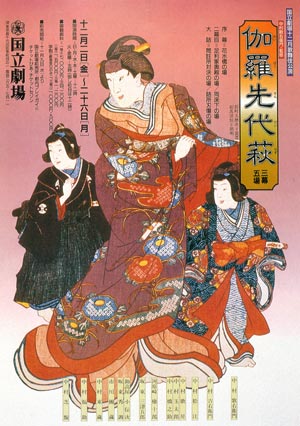| Meiboku Sendai Hagi |
| Play title | Meiboku Sendai Hagi Date Kurabe Okuni Kabuki |
| Authors | Nagawa Kamesuke I Isojii Sosuke Sakurada Jisuke I Kasanui Sensuke I |
| History |
"Meiboku Sendai Hagi" has a complicated history: it was staged for the first time in the 4th lunar month of 1777 as a 5-act drama written by Nagawa Kamesuke I and Isojii Sosuke, which was produced in ďsaka at the Naka no Shibai [casting]. This drama was inspired by "Keisei Mutsu no Tamagawa", the first play dealing with the Date succession troubles, which was staged in the 1st lunar month of 1767 at the Naka no Shibai. Sakurada Jisuke I and Kasanui Sensuke I wrote a similar drama, which was entitled "Date Kurabe Okuni Kabuki" and staged for the first time in the 7th lunar month of 1778 at the Nakamuraza [casting]. Then, the playwrights Matsu Kanshi, Takahashi Buhei and Yoshida Kadomaru wrote a play in 9 acts for the puppet theater, using the title "Meiboku Sendai Hagi" and mixing elements from both the original "Meiboku Sendai Hagi" and "Date Kurabe Okuni Kabuki". This puppet drama was staged for the first time in the 1st lunar month of 1785 in Edo at the Yűkiza. It was afterwards adapted for Kabuki and evolved during the nineteenth century. "The play is based on a real event involving the Date clan of Sendai during the 1660's, but censorship prevented contemporary incidents being dramatized, so the drama was set during the Muromachi period (1336-1568), and names were changed to disguise the protagonists' identity." (text courtesy of Jean Wilson 1998) The 17th Date clan was replaced by the 15th Ashikaga clan and Lord Date Tsunamune, the cause of the succession troubles, became Ashikaga Yorikane in the Kabuki drama. |
| Structure |
The current version of "Meiboku Sendai Hagi" is made up of 3 acts and 6 scenes. |
| Key words |
Aragoto Date S˘d˘ Jidaimono Giri/Ninj˘ Hosokawa Katsumoto Jitsuaku Nezumi Oiemono Sabakiyaku S˘d˘ |
| Summary |
Act I, scene 1 (classic introduction scene): "the Hanamizu Bridge" The samurai lord Yorikane has fallen in love with the courtesan Takao and has neglected responsibilities, causing high-ranking retainers to plot the takeover of his domain. Returning from the pleasure quarters, he is attacked at Hanamizu Bridge, but is able to escape thanks to the help of a sum˘ wrestler retainer named Kinugawa Taniz˘. Act I, scene 1 (alternate opening scene): "the Takaomaru boat" Yorikane is entertaining his courtesan lover Takao on the Takaomaru, a boat which he has named in her honor. He plans to buy out her contract and have her live with him, but while he takes a nap, a loyal servant convinces Takao to finish with Yoritane for his family's sake, and so when he reappears, she says there is someone else in her life and her affair with Yoritane to date has been a deception. Enraged and humiliated, he stabs and kills her. Act II, scene 1 ("the Bamboo Room") and scene 2 ("the Palace") Yorikane has been removed from office, but now the titular head of the clan is his young son Tsuruchiyo, a very vulnerable target to the forces trying to take over the clan. Masaoka, the boy's nurse is desperately afraid that he will be poisoned. She refuses to let anyone see him who might try to assassinate him and attempts to keep him safe in the women's quarters where men are forbidden. She even fixes his meal in her quarters using her delicate tea ceremony implements to cook rice. The plotting faction does not give up, though, and sends poison in the form of candy as a present from the Sh˘gun. Masaoka's son sacrifices his life for the young lord by eating the poisoned candy, and when he is killed, Masakoa thinks only of protecting her lord. Her fierce devotion to duty convinces the plotters that she is on their side. Masaoka's actions help save the young lord, and only when she is alone can she grieve for her son. Act II, scene 3: "Below the floor" Another faithful retainer Otokonosuke stands guard underneath the room, but the evil Nikki Danj˘ appears as a giant rat, but then slips away, walking calmly through the clouds. Act III, scene 1 ("the Trial") and scene 2 ("the Stabbing") In the final act, an elderly, faithful retainer, Geki, seeks to uphold the legality of Tsuruchiyo's succession to his father's position, but the judge is in Nikki Danj˘'s pay and finds against him. However, a second judge, Hosokawa Katsumoto makes his entrance and through a clever series of questions and answers reveals Danj˘'s testimony to be lies and orders him to be stripped of his rank and condemned to death. Danj˘ stabs Geki and tries to fight his way out but fails. Source for Act I (classic) and Act II: Earphone Guide website |
 |
|
The poster of the production of "Meiboku Sendai Hagi", which was staged in December 1988 at the National Theatre |
|
|
| Contact | Main | Top | Updates | Actors | Plays | Playwrights | Programs | Links | FAQ | Glossary | Chronology | Illustrations | Prints | Characters | Derivatives | Theaters | Coming soon | News |